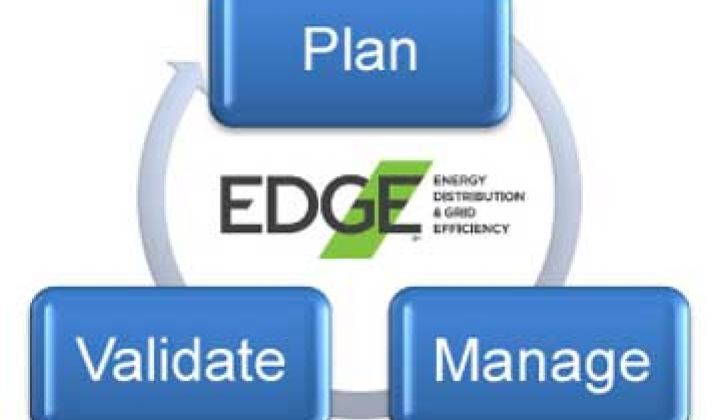When Dominion Virginia Power was putting together its business plan for advanced metering infrastructure, it wasn’t just fewer truck rolls or better customer service that helped to justify smart meters across its territory.
One of the key benefits was conservation voltage reduction, a distribution automation application where utilities bring down and fine-tune the voltage on circuits to save power overall.
Dominion Virginia Power set out to find a product that would allow the utility to leverage the smart meters for voltage conservation, all while measuring and verifying what was being controlled. The utility, which has 2.3 million customers, could not find anything that met its needs, according to Mary Doswell, senior vice president for Alternative Energy Solutions at Dominion. Instead, the team decided to build its own application.
More than three years later, the Edge platform is connected to about 80,000 smart meters in Dominion Virginia Power’s territory and is being sold into the market by Dominion Voltage Inc., which developed the technology in conjunction with Lockheed Martin.
Doswell said they have more interest from utilities than they can handle and have various pilots in the works, although she would not comment on where those pilots were taking place.
“We have loads of interest,” she said. “We basically can’t keep up.”
The appeal of CVR is simple. For utilities that are decoupled or incentivized for energy efficiency measures, CVR can cut power usage by a few percentage points, similar to what some baseline customer interaction programs, like the reports Opower produces, can deliver. All of this can happen without customers being affected at all. For every 1 percent of reduction in voltage, most estimates find a 0.7 percent to 0.8 percent reduction in power consumption.
The concept of CVR has been around for decades. Utilities would manually adjust load tap changers and voltage regulators to lower demand during critical peak periods. Most utilities also incorporate a modeling of the distribution circuit to ensure that voltage isn’t dropping too low at the end of the line.
Software and connected grid assets have made it possible to optimize voltage reduction, an application broadly referred to as volt/VAR optimization (VVO). The systems are either integrated with a distribution management system or can sit as an individual application. Most of the large power automation companies have VVO offerings, including ABB, Cooper Power, General Electric and Siemens. Startups like Utilidata are also offering novel VVO applications. Entergy is another utility that is testing its AMI for voltage reduction.
Unlike many other products on the market, Dominion’s Edge does not require modeling of circuits, or anything much more than smart meters and some control equipment on the grid itself, to adjust the voltage. “The core piece of the information that other systems don’t have is that we’re reading the voltage right at the delivery point,” said Phil Powell, director of grid innovations for Dominion Voltage, a subsidiary of Dominion. The product has several meter partners, including Elster, Landis+Gyr and Silver Spring Networks.
Controlling voltage to tens of thousands of endpoints would overwhelm the AMI communications system, so instead, Edge monitors a subset of meters but constantly looks for abnormalities to add into the subset. “It’s essentially an adaptive routine that searches the circuit,” said Powell. That allows Edge to leverage the smart meter’s communications platform without requiring additional bandwidth that some distribution automation applications would require.
“The basic idea is that if I know what the customer level is, and I know what I’m supplying at the substation, that’s all I need,” said Powell.
Because it leverages AMI, the system just needs the location of the meters, and a utility does not necessarily have to have GIS, although that helps. “At a minimum level, each utility has to know the customer meter location which ties it to a geospatial location,” she said. “We can translate that into a geospatial mapping.”
In Virginia, the voltage reduction has been close to 3 percent for the years it’s been in place. The product will be extended to another 20,000 customers in Dominion Virginia Power’s territory for a total of 100,000 customers. There is a verification feature on Edge that allows grid operators to constantly monitor the voltage savings and make adjustments as necessary.
The sales team is looking for any utility that has AMI, as well as co-ops, which often are more incentivized to reduce consumption. “When we compare it to other energy efficiency programs,” said Powell, “we’re well under the cost per kilowatt-hour for those programs.” The system has about a 12- to 18-month payback.
Currently, the product is primarily about energy efficiency, but that’s just the beginning, said Doswell. In particular, Edge could be used to monitor and adjust for voltage fluctuations at endpoints where customers have distributed generation, such as rooftop solar. Edge could also be one product that could help manage a microgrid. “This is the beginning of grid management,” said Doswell, “There’s so much beyond this.”
The need for solutions to deal with everything from distributed generation to electric vehicles at the edge of the grid is just one of the topics that will be covered in the upcoming Greentech Media conference, The Soft Grid, August 14-15 in San Francisco, California.



